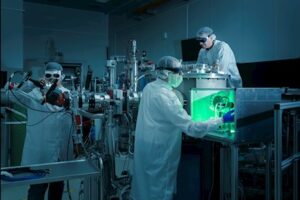ELI ERIC’s 5th User Call Highlights Rising Demand and Research Excellence
The 5th ELI ERIC User Call concluded, marking another milestone in the organisation’s mission to advance high-power laser science. The 136 proposals submitted involving over 450 scientists from 35 countries is a new record for the ELI User Programme. With 90 accepted proposals for implementation, achieving a 66.2% acceptance rate, the growing demand for ELI’s state-of-the-art facilities is highlighted.
“The continued growth of the ELI User Programme is evident now not only in the number of proposals, but also in the increasing quality,” said ELI ERIC Director General Allen Weeks. “New instruments coming online is a big factor driving demand, and we are seeing returning users as well.”
The proposals approved in this cycle also reflect ELI’s multidisciplinary focus, spanning fields such as materials and surface science, atomic and molecular physics, life sciences, and particle acceleration. Materials and surface science dominated the call, with 30 accepted proposals addressing advanced research on the microscopic properties of materials. This area has consistently received the highest number of proposals across all User Calls, making it a key community for ELI.
Atomic, molecular, and optical physics in gas and liquid phases was another prominent area, with 19 projects approved to investigate dynamic interactions at the atomic level. In life sciences, 11 projects secured approval to use laser technologies for medical and biological advancements, including cutting-edge imaging techniques. Other notable areas included particle acceleration and relativistic interactions, demonstrating ELI’s capacity to enable transformative research in fundamental and applied physics.
The call’s results also illustrate the international appeal of ELI’s facilities, with Hungary leading in submissions, followed by submissions from Czechia, the United States, United Kingdom and Austria. For the first time a proposal from Africa was submitted. The diverse geographic participation underlines the global relevance of ELI’s laser systems and the research they enable.
As the Joint User Programme develops, the ELI Facilities continue to enhance the technical performance parameters of their experimental suite, while also ramping up and integrating further scientific equipment into the offer. Laser capabilities continue to advance with improvements to the HF-PW laser and the HR laser cluster at ELI ALPS. At ELI Beamlines, the L3 HAPLS laser system was used in parallel operation which contributed to the successful commissioning of the Gammatron beamline, a multidisciplinary platform using hard X-ray radiation from a laser-plasma accelerator.
The peer review process is critical in ensuring that the most promising proposals were selected. “The quality of the proposals in this [5th] Call was exceptional,” says Charlotte Palmer of Queens University Belfast and Chair of the Particle Acceleration and Applications Peer Review Panel. “I’m very happy to say that we managed to push through the really highest rated projects and I’m looking forward to seeing many of them implemented.”
Some accepted proposals were scientifically interesting, but not feasible in the allotted time periods. Others were approved conditionally, with acceptance subject to clarifications or user commitments, ensuring that the projects align with ELI’s operational and scientific goals.
To support ambitious, long-term projects that aim to push research, ELI recently launched the first Mission-Based Access Programme focused on Inertial Fusion Energy (IFE) to push research in laser-driven fusion physics and technology. Through this programme, ELI aims to foster collaboration between researchers from academia, research institutes, and industry, helping to solve complex, multidisciplinary problems and drive innovation in fusion energy.
As the successful proposals begin their work, ELI ERIC is set to push the frontiers of laser science and technology. With new instruments on the horizon and a steadily growing community of users, ELI continues to solidify its position as a global leader in high-power laser research.
